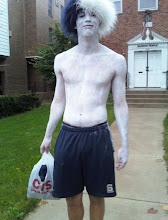Sunday, January 31, 2010
Reading #3
The second reading focus’ on the demoralization of women through reality TV shows. It suggests that shows like “next” and “the real world” promote people to view women as objects of society. The writer argues that feminism in America has to be dead, since girls openly watch and support the shows on television. According to the author, girls are introduced as objects, while guys have the right to “next” them at any point for no legitimate reason.
My personal belief on all of this is the television does have a lasting impact on society. The most obvious example of this would have to be the Bart Simpson situation that was previously mentioned. I believe that some of the reality TV opinions are true. However, I believe its works that same way for both sexes. For example, the show next uses guys and girls as the “nexters”. All in all, there seems to be a deeper meaning in even the most simple types of television that we watch.
Tuesday, January 26, 2010
Second Reading
The second reading (pages 119-124) offers a completely different take on the world compared to the first reading. First, instead of referring to symbols and signs, it shifts its focus on the effect that television has on households across America. It states that television is meant for passive viewing. The show is on whether we decide to watch it or not and stops for almost nothing. There is no text or paragraphs to analyze and no way we can “bookmark” a show half way through without the rest of the world viewing it. This offers many obvious differences between a novel and a typical sitcom. Also, it claims that these shows lack a distinct author (unlike books) and rely on a heavy genre present to help drive the plot. Often times when reading the themes have to be dissected out of the text. Without deep thought, the author’s key points and lesson can be easily passed by. TV on the other hand has a more obvious effect on its viewers. The genre (drama, western, action, romance) is often apparent within the first several minutes of viewing. The themes that follow are unmistakable and hard to pass by. The reading then shifts its focus to the content of the shows. For example, many shows such as Seinfeld contain almost an entirely all white cast. On the other hand, almost all of the shows produced by Tyler Perry focus on the typical African family. Although the diversity in standard television has increased over the years, some shows leave certain ethnicities out, detracting from the overall quality of the program.
All in all, I enjoyed this reading MUCH more the than first. The different matters brought up made me think twice about the television that I watch, how I watch it, and what I’ve come to expect from the programming industry. It also brought to light the unnecessarily large amount of money that I, along with other Americans, spend on television each year. In short, I tend to agree with just about every part of this reading and believe that it shared many truths with me that otherwise would have been undetected.
Tuesday, January 19, 2010
First Reading pages 1-21
In conclusion, I believe that this reading assignment has several good points. For example, the mention of all the signs is something that i can really relate to in real life. For example, the stop sign that was used as an example offers several key points. It shows that there are many elements of a sign that change the way i judge and interpreted it. the combonations of the bold text and the bright red color help to grab my attention. If a sign lacks one of these elements, then the stop sign becomes awkward and difficult to recognize.


